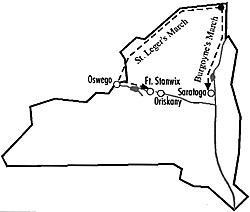 The great comedy of errors also known as the Saratoga campaign
generally has it's focus on the movement and battles involving Lieutenant
General John Burgoyne. Undoubtedly the two bloody stalemate battles
of Freeman's Farm and Bemis Heights, combined with Burgoyne's
untenable position in central New York, far from anyone friendly, were
the major contributors to his defeat and France's entry into what was
becoming the second world war of the 18th century. And yet, certain
plans that Burgoyne set in motion quickly ranged out of his control and
had unforeseen consequences that would ultimately affect the survival of
his army.
The great comedy of errors also known as the Saratoga campaign
generally has it's focus on the movement and battles involving Lieutenant
General John Burgoyne. Undoubtedly the two bloody stalemate battles
of Freeman's Farm and Bemis Heights, combined with Burgoyne's
untenable position in central New York, far from anyone friendly, were
the major contributors to his defeat and France's entry into what was
becoming the second world war of the 18th century. And yet, certain
plans that Burgoyne set in motion quickly ranged out of his control and
had unforeseen consequences that would ultimately affect the survival of
his army.
Operations like the poorly planned raid which resulted in the loss of 800 British troops at the Battle of Bennington did little to help the campaign. Moreover, the complete lack of coordinated action by General Howe moving up the Hudson from New York or the series of actions under the nominal command of Barry St. Leger, the third "prong" of Burgoyne's grand plan to carve up the northern colonies, doomed the operation almost from it's outset. It was during this "diversionary" expedition that the Battle of Oriskany occurred, another "effor" which ultimately contributed to the collapse of major British operations in the northern colonies for the remainder of the war.
Barry St. Leger commanded a little over 2000 troops, half of whom were Indians, mostly Iroquois. St. Leger's ultimate goal was to move down the Mohawk Valley from the town of Oswego and hook up with Burgoyne in Albany. While considered by many historians a diversionary action , St Leger was in fact undertaking a standard British operation during the war of moving through an area with a sizeable Tory population, recruit, and re-establish British control. Because of Tory sympathies in the area, strong support from the Indian population, and an almost total lack of organized American opposition, neither Burgoyne not St. Leger expected significant problems during the march. But that assumption would be incorrect and it typified most British thinking when it came to planning operations in areas with sizeable Tory populations; British commanders inevitably underestimated their own capabilities, Tory support, and the vehemence of Patriot opposition.
The only "thing" standing in the way of St. Leger and Albany when he left Oswego on 26 July 1777 was crumbling old Fort Stanwix, built in 1758 to control the portages which linked the Mohawk River and the numerous streams feeding into the watershed that flowed into Lake Ontario. It had been abandoned for many years but as news of the Burgoyne/St. Leger operation spread in early 1777, a Continental infantry detachment of about 500 men arrived at Stanwix in April and began hurried efforts to make the fort somewhat defensible when St. Leger was expected to arrive sometime later that summer.
One other "thing" began to take shape to block St. Leger's easy march through the Mohawk Valley, this occuring just one week before the combined British/Tory/Indian force was to leave Oswego. The Mohawk Valley Patriot population finally realized that their fate rested in the hands of 500 Continentals defending a fort of questionable strength who were also outnumered 4: 1. Therefore, the local militia brigadier general, Nicholas Herkimer, called out the local militia and set forth to reinforce Stanwix on 4 August, the day after St. Leger had arrived at the fort and began siege operations.
Herkimer wanted to march cautiously as he neared the fort since he suspected the chances of being ambushed were great and he had not coordinated his actions with the Continentals at Fort Stanwix. However, his four regimental commanders would have nothing of this. At a council of war on the morning of 6 August 1777, his regimental commanders urged immediate action and as the argument wore on, they even began accusing him of disloyalty and cowardice. Finally he gave in and the four regiments, complete with their supply train pulled by ox carts, began a fast march over the remaining dozen or so miles to Fort Stanwix.
St. Leger had been informed of Herkimer's approach and decided to send a force to ambush the approaching Americans. Under command of Sir John Johnson, the scion of a noteworthy Mohawk Valley Tory family, St. Leger dispatched about 400 Indians and 100-150 Tory regulars. The ambush location was about 6 miles from the fort and would catch the Americans crossing a ravine and a stream swollen by rain. The Tory regulars provided the blocking force while the Indians were arrayed along both sides of the road. All were well hidden in such a way that would have made the French commanders who ambushed Braddock proud. The Americans walked neatly into the trap.
More Oriskany
-
Battle of Oriskany: Introduction
Battle of Oriskany: Order of Battle and Rules
Battle of Oriskany: Historical Outcome
ED NOTE: Scott is the author of the rules Patriots & Loyalists which are available from Wargames. Box 278, Rte 40 East, Triadelphia, WV 26059
Back to Table of Contents -- Courier #77
To Courier List of Issues
To MagWeb Master Magazine List
© Copyright 1999 by The Courier Publishing Company.
This article appears in MagWeb (Magazine Web) on the Internet World Wide Web.
Other military history articles and gaming articles are available at http://www.magweb.com